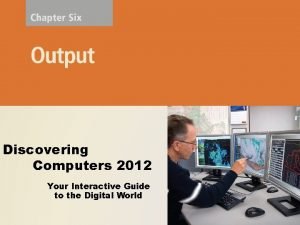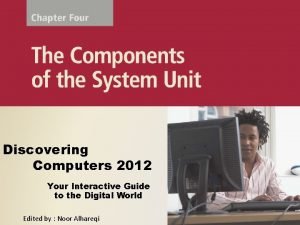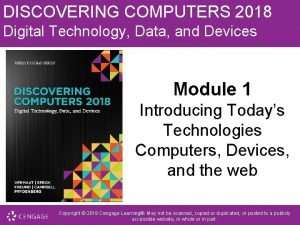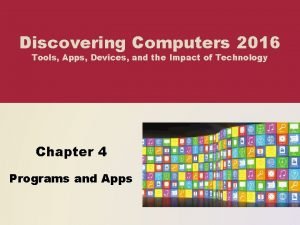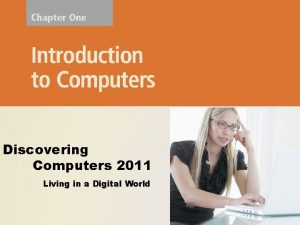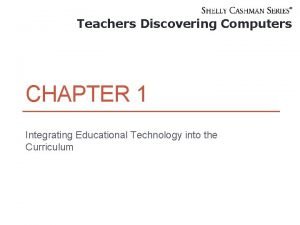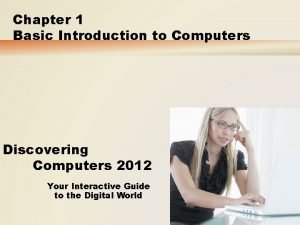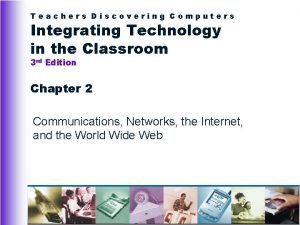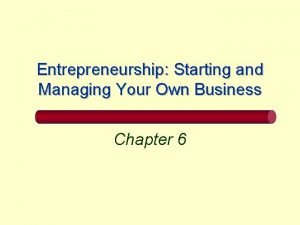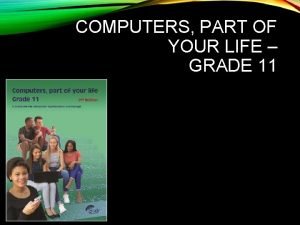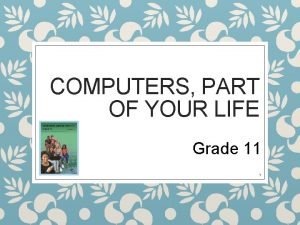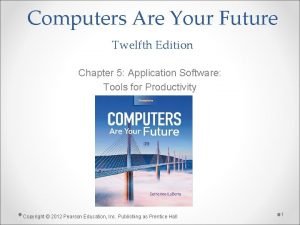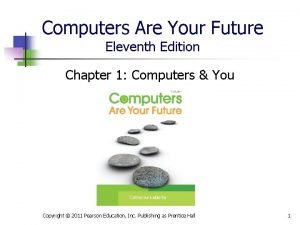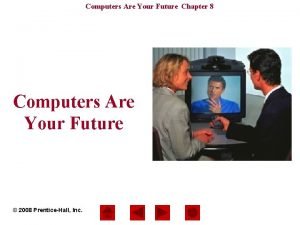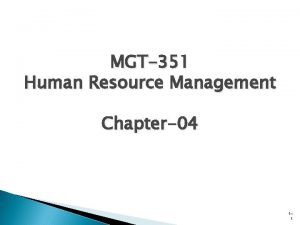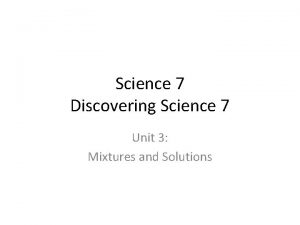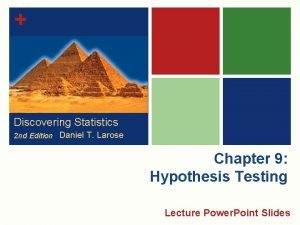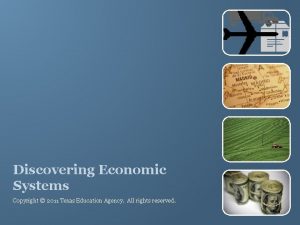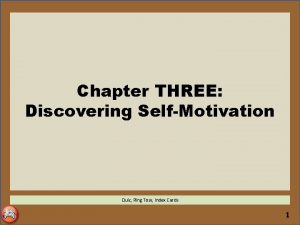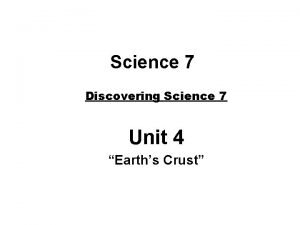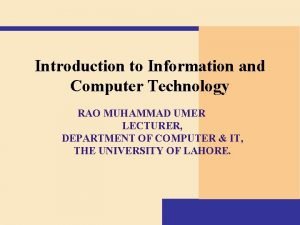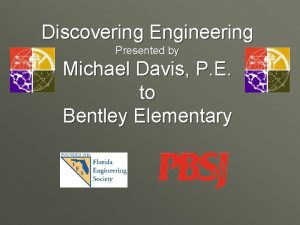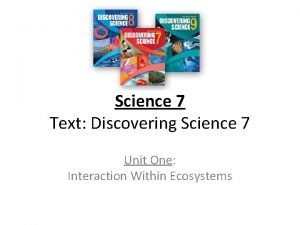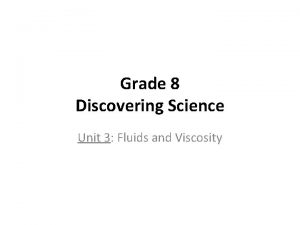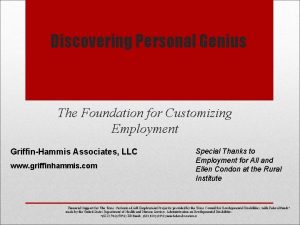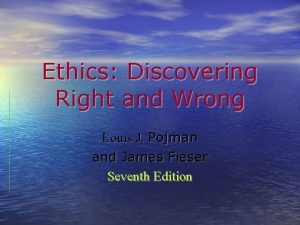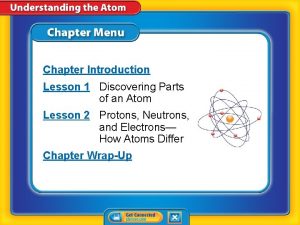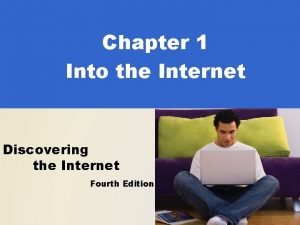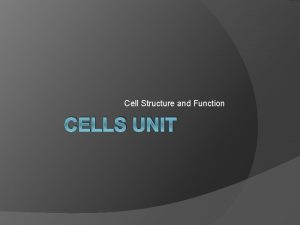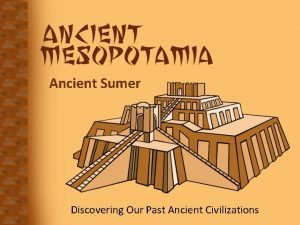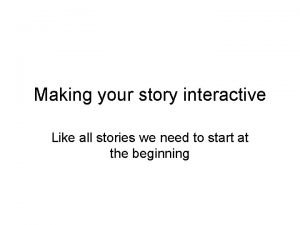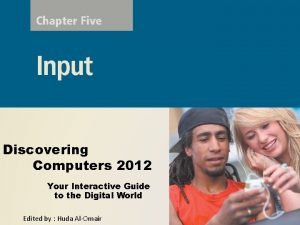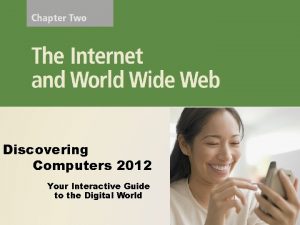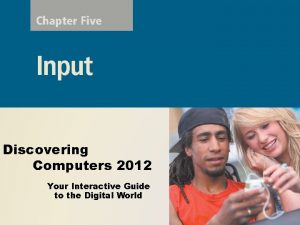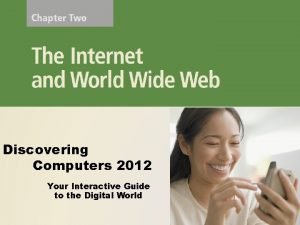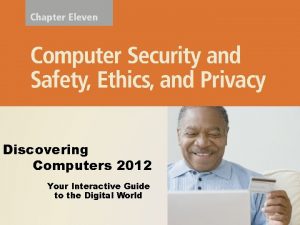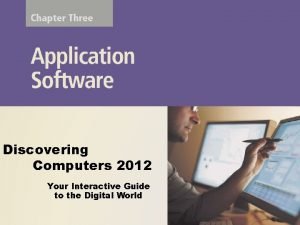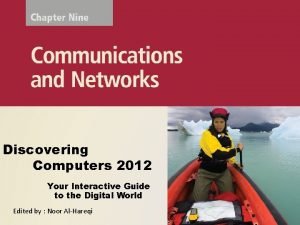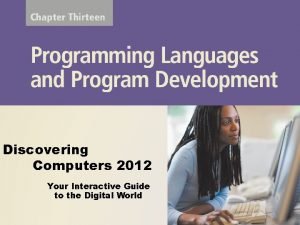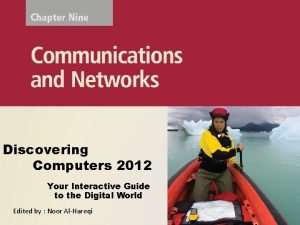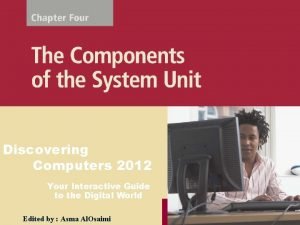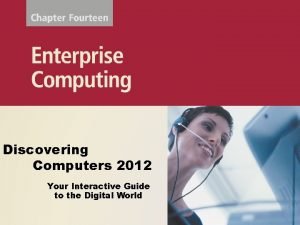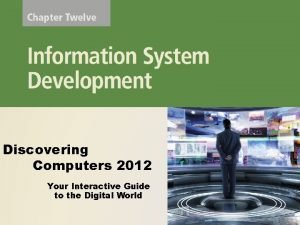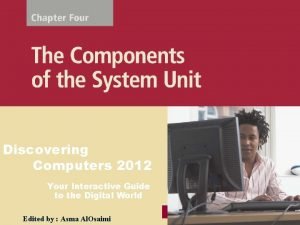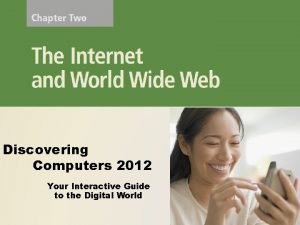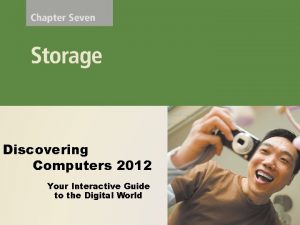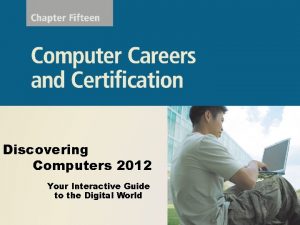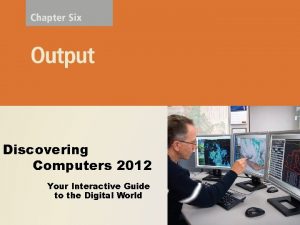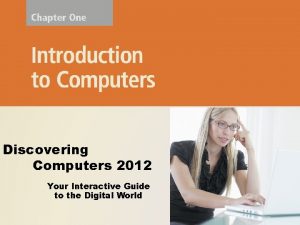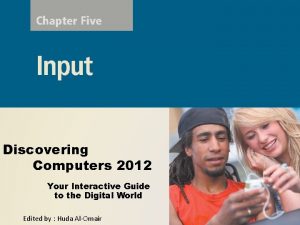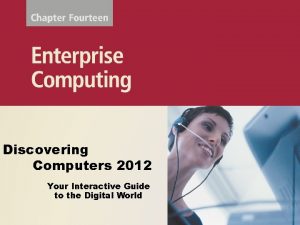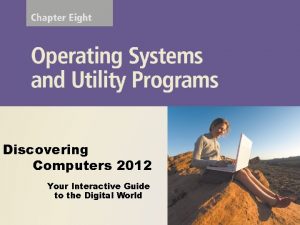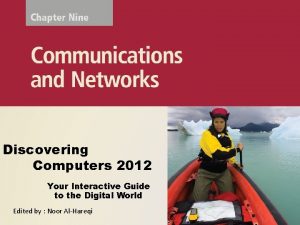Discovering Computers 2012 Your Interactive Guide to the





































- Slides: 37

Discovering Computers 2012 Your Interactive Guide to the Digital World

Objectives Overview Differentiate among various styles of system units on desktop computers, notebook computers, and mobile devices Identify chips, adapter cards, and other components of a motherboard Describe the control unit and arithmetic logic unit components of a processor, and explain the four steps in a machine cycle Identify characteristics of various personal computer processors on the market today, and describe the ways processors are cooled Define a bit and describe how a series of bits represents data Explain how program instructions transfer in and out of memory See Page 209 for Detailed Objectives Discovering Computers 2012: Chapter 4 2

Objectives Overview Differentiate among the various types of memory Describe the purpose and types of expansion slots and adapter cards, and differentiate among slots for various removable flash memory devices Differentiate between a port and a connector, and explain the differences among a USB port, Fire. Wire port, Bluetooth port, SCSI port, e. SATA port, Ir. DA port, serial port, and MIDI port Describe the types of buses in a computer Explain the purpose of a power supply and describe how it keeps cool Understand how to clean a system unit on a computer or mobile device See Page 209 for Detailed Objectives Discovering Computers 2012: Chapter 4 3

The System Unit • The system unit is a case that contains electronic components of the computer used to process data Page 210 Figure 4 -1 Discovering Computers 2012: Chapter 4 4

The System Unit • The inside of the system unit on a desktop personal computer includes: Drive bay(s) Power supply Sound card Video card Processor Memory Page 211 Figure 4 -2 Discovering Computers 2012: Chapter 4 5

The System Unit • The motherboard is the main circuit board of the system unit. Page 212 Figure 4 -3 Discovering Computers 2012: Chapter 4 6

Processor • The processor, also called the central processing unit (CPU), interprets and carries out the basic instructions that operate a computer – Contain a control unit and an arithmetic logic unit (ALU) Multi-core processor Page 213 Dual-core processor Discovering Computers 2012: Chapter 4 Quad-core processor 7

Processor Page 213 Figure 4 -4 Discovering Computers 2012: Chapter 4 8

Processor • The control unit is the component of the processor that directs and coordinates most of the operations in the computer(control the management of a computer) • The arithmetic logic unit (ALU) performs arithmetic, comparison, and other operations Page 214 Discovering Computers 2012: Chapter 4 9

Processor The processor contains registers, that temporarily hold data and instructions The system clock controls the timing of all computer operations Page 216 Discovering Computers 2012: Chapter 4 10

Processor • A processor chip generates heat that could cause the chip to burn up • Require additional cooling – Heat sinks – Liquid cooling technology Pages 219 - 220 Figures 4 -9 – 4 -10 Discovering Computers 2012: Chapter 4 11

Processor • Parallel processing uses multiple processors simultaneously to execute a single program or task – Massively parallel processing involves hundreds or thousands of processors Page 220 Figure 4 -11 Discovering Computers 2012: Chapter 4 12

Data Representation • ASCII (American Standard Code for Information Interchange) is the most widely used coding scheme to represent data Page 221 Figure 4 -14 Discovering Computers 2012: Chapter 4 13

Memory • Memory consists of electronic components that store instructions waiting to be executed by the processor, data needed by those instructions, and the results of processing the data • Stores three basic categories of items: The operating system and other system software Page 223 Application programs Discovering Computers 2012: Chapter 4 Data being processed and the resulting information 14

Memory • Each location in memory has an address • Memory size is measured in kilobytes (KB or K), megabytes (MB), gigabytes (GB), or terabytes (TB) Page 223 Figure 4 -17 Discovering Computers 2012: Chapter 4 15

Memory • The system unit contains two types of memory: Volatile memory Nonvolatile memory Loses its contents when power is turned off Does not lose contents when power is removed Example includes RAM Examples include ROM, flash memory Pages 223 - 224 Discovering Computers 2012: Chapter 4 16

Memory • RAM chips usually reside on a memory module and are inserted into memory slots Page 225 Figure 4 -20 Discovering Computers 2012: Chapter 4 17

Memory • Memory cache speeds the processes of the computer because it stores frequently used instructions and data Page 227 Figure 4 -22 Discovering Computers 2012: Chapter 4 18

Memory Read-only memory (ROM) refers to memory chips storing permanent data and instructions A PROM (programmable read-only memory) chip is a blank ROM chip that can be written to permanently • EEPROM can be erased Page 228 Discovering Computers 2012: Chapter 4 19

Expansion Slots and Adapter Cards • An expansion slot is a socket on the motherboard that can hold an adapter card • An adapter card enhances functions of a component of the system unit and/or provides connections to peripherals – Sound card and video card Page 230 Figure 4 -26 Discovering Computers 2012: Chapter 4 20

Ports and Connectors A port is the point at which a peripheral attaches to or communicates with a system unit (sometimes referred to as a jack) A connector joins a cable to a port Page 232 Discovering Computers 2012: Chapter 4 21

Ports and Connectors Page 232 Figure 4 -29 Discovering Computers 2012: Chapter 4 22

Ports and Connectors • On a notebook computer, the ports are on the back, front, and/or sides Pages 232 - 233 Figure 4 -30 Discovering Computers 2012: Chapter 4 23

Ports and Connectors Page 233 Figure 4 -31 Discovering Computers 2012: Chapter 4 24

Ports and Connectors • A USB port can connect up to 127 different peripherals together with a single connector – You can attach multiple peripherals using a single USB port with a USB hub Page 234 Figure 4 -32 Discovering Computers 2012: Chapter 4 25

Ports and Connectors • Other types of ports include: Firewire port Bluetooth port SCSI port e. SATA port Ir. DA port Serial port MIDI port Pages 234 - 236 Discovering Computers 2012: Chapter 4 26

Ports and Connectors A Bluetooth wireless port adapter converts a USB port into a Bluetooth port Page 235 Figures 4 -33 – 4 -34 A smart phone might communicate with a notebook computer using an Ir. DA port Discovering Computers 2012: Chapter 4 27

Ports and Connectors • A port replicator is an external device that provides connections to peripherals through ports built into the device • A docking station is an external device that attaches to a mobile computer or device Page 236 Figure 4 -35 Discovering Computers 2012: Chapter 4 28

Buses • A bus allows the various devices both inside and attached to the system unit to communicate with each other – Data bus – Address bus • Word size is the number of bits the processor can interpret and execute at a given time Page 237 Figure 4 -36 Discovering Computers 2012: Chapter 4 29

Buses • Expansion slots connect to expansion buses • Common types of expansion buses include: PCI bus PCI Express bus USB and Fire. Wire bus Page 238 Accelerated Graphics Port PC Card bus Discovering Computers 2012: Chapter 4 30

Bays • A bay is an opening inside the system unit in which you can install additional equipment – A drive bay typically holds disk drives Page 238 Figure 4 -37 Discovering Computers 2012: Chapter 4 31

Power Supply The power supply converts the wall outlet AC power into DC power Some external peripherals have an AC adapter, which is an external power supply Page 239 Discovering Computers 2012: Chapter 4 32

Putting It All Together Home Intel Core i 5 or Intel Core 2 i 3 or AMD Athlon II or AMD Sempron Minimum RAM: 2 GB Page 239 Figure 4 -38 Small Office/ Home Office Intel Core i 7 or Intel Core i 7 Extreme or AMD Phenom II or AMD Athlon II Minimum RAM: 4 GB Discovering Computers 2012: Chapter 4 Mobile Intel Core i 7 Extreme or Intel Core i 7 or AMD Phenom II or AMD Turion II Minimum RAM: 2 GB 33

Putting It All Together Power Intel Xeon or Intel Itanium or AMD Opteron Minimum RAM: 8 GB Enterprise Intel Core i 7 or Intel Core i 7 Extreme or AMD Phenom II or AMD Athlon II Minimum RAM: 4 GB Page 239 Figure 4 -38 Discovering Computers 2012: Chapter 4 34

Keeping Your Computer or Mobile Device Clean your computer or mobile device once or twice a year Turn off and unplug your computer or mobile device before cleaning it Use compressed air to blow away dust Use an antistatic wipe to clean the exterior of the case and a cleaning solution and soft cloth to clean the screen Page 240 Discovering Computers 2012: Chapter 4 35

Summary Components of the system unit How memory stores data, instructions, and information Comparison of various personal computer processors on the market today Page 241 Sequence of operations that occur when a computer executes an instruction How to clean the exterior and interior of a system unit Discovering Computers 2012: Chapter 4 36

Discovering Computers 2012 Your Interactive Guide to the Digital World Chapter 4 Complete
 Tactile output
Tactile output The system generates regular electronic pulses
The system generates regular electronic pulses Discovering computers 2018 ppt
Discovering computers 2018 ppt Discovering computers 2016
Discovering computers 2016 Discovering computers 2011
Discovering computers 2011 Discovering computers 2018 chapter 1
Discovering computers 2018 chapter 1 Discovering computers
Discovering computers Teachers discovering computers
Teachers discovering computers Write your answer on your notebook
Write your answer on your notebook Interactive guide to healthy eating and active living
Interactive guide to healthy eating and active living Serve as your guide in managing your enterprise
Serve as your guide in managing your enterprise Computer part of your life grade 11
Computer part of your life grade 11 Computers, part of your life grade 11 answers pdf
Computers, part of your life grade 11 answers pdf Computers are your future 12th edition pdf
Computers are your future 12th edition pdf Computers are your future
Computers are your future Computers are your future
Computers are your future Participant diary/log
Participant diary/log Discovering the humanities 3rd edition
Discovering the humanities 3rd edition Self motivation meaning
Self motivation meaning Pure substances
Pure substances P value in statistics
P value in statistics Discovering economic systems comparative worksheet answers
Discovering economic systems comparative worksheet answers Chapter 3 discovering self motivation quiz
Chapter 3 discovering self motivation quiz Rock vs mineral
Rock vs mineral Muhammad computer technology
Muhammad computer technology Discovering engineering
Discovering engineering Discovering american ideals in primary sources
Discovering american ideals in primary sources Pioneer species
Pioneer species Grade 8 science fluids
Grade 8 science fluids A r williams author of discovering tut
A r williams author of discovering tut Discovering personal genius
Discovering personal genius Ethics discovering right and wrong
Ethics discovering right and wrong Chapter 7 lesson 1 discovering parts of an atom answer key
Chapter 7 lesson 1 discovering parts of an atom answer key Discovering the internet
Discovering the internet Discovering cells
Discovering cells Discovering our past ancient civilizations
Discovering our past ancient civilizations Your story interactive
Your story interactive Give us your hungry your tired your poor
Give us your hungry your tired your poor
